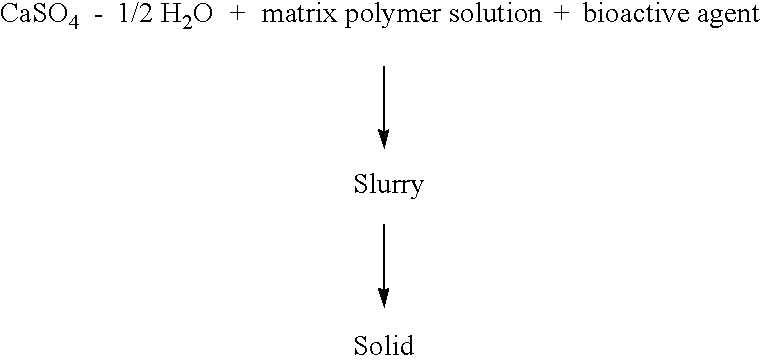Resorbable matrices for delivery of bioactive compounds
a bioactive compound and matrice technology, applied in the direction of biocide, osteosynthesis device, prosthesis, etc., can solve the problems of incompatibility of polypeptides with organic solvents, inability to resorb, and inability to resorb
- Summary
- Abstract
- Description
- Claims
- Application Information
AI Technical Summary
Benefits of technology
Problems solved by technology
Method used
Image
Examples
example 1
Synthesis of Amikacin Pamoate
Disodium pamoate (865 mg) was dissolved in a minimum amount of water. Amikacin sulfate (782 mg), dissolved in a minimum amount of water, was added to the sodium pamoate solution and mixed thoroughly at room temperature. The precipitate was collected by filtration and washed with two portions (5 ml) of cold water. The material was dried in a vacuum dessicator for 48 hrs.
Yield: 70%. MP: 235-244.degree. with decomposition.
example 2
Synthesis of Clindamycin Pamoate
Disodium Pamoate (216 mg) was dissolved in a minimum amount of water. Clindamycin-HCl (461 mg), dissolved in a minimum amount of water, was added to the sodium pamoate solution and mixed thoroughly at room temperature. The precipitate was collected by filtration and washed with two portions (5 ml) of cold water. The material was dried in a vacuum dessicator for 48 hrs.
Yield: 78%. MP: 189-194.degree..
example 3
Preparation of Calcium Sulfate / calcium Stearate Formulation Containing Enrofloxacin
Calcium sulfate and calcium stearate powders were thoroughly mixed in a weight ratio of 19 / 1. This mixture (1 g) was then blended with finely ground enrofloxacin (160 mg). To this solid mixture was added 0.6 ml of polyethyleneglycol solution (PEG-MW 8,000, 10% w / v). The slurry was mixed for one minute and then allowed to solidify in bulk or was injected into a teflon mold for the production of 3 mm beads.
PUM
| Property | Measurement | Unit |
|---|---|---|
| compressive strength | aaaaa | aaaaa |
| diameter | aaaaa | aaaaa |
| mixing time | aaaaa | aaaaa |
Abstract
Description
Claims
Application Information
 Login to View More
Login to View More - R&D
- Intellectual Property
- Life Sciences
- Materials
- Tech Scout
- Unparalleled Data Quality
- Higher Quality Content
- 60% Fewer Hallucinations
Browse by: Latest US Patents, China's latest patents, Technical Efficacy Thesaurus, Application Domain, Technology Topic, Popular Technical Reports.
© 2025 PatSnap. All rights reserved.Legal|Privacy policy|Modern Slavery Act Transparency Statement|Sitemap|About US| Contact US: help@patsnap.com

